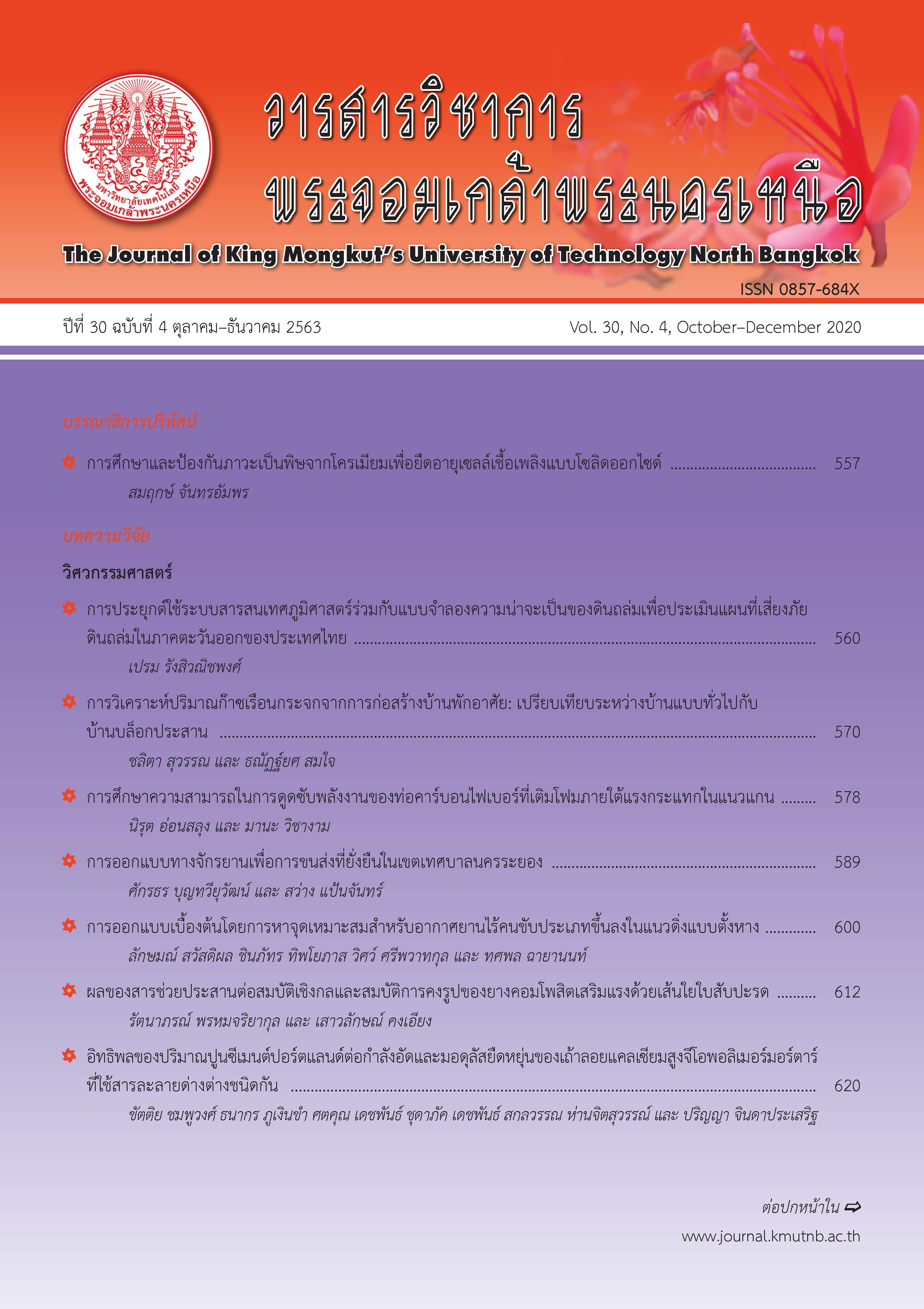อิทธิพลของปริมาณปูนซีเมนต์ปอร์ตแลนด์ต่อกำลังอัดและมอดุลัสยืดหยุ่นของเถ้าลอยแคลเซียมสูงจีโอพอลิเมอร์มอร์ตาร์ที่ใช้สารละลายด่างต่างชนิดกัน
Main Article Content
บทคัดย่อ
บทความนี้เป็นการศึกษาผลกระทบของชนิดสารละลายด่างต่อกำลังอัด และมอดุลัสยืดหยุ่นของเถ้าลอยแคลเซียมสูงจีโอพอลิเมอร์มอร์ตาร์ผสมปูนซีเมนต์ปอร์ตแลนด์ เถ้าลอยแคลเซียมสูงถูกแทนที่ด้วยปูนซีเมนต์ปอร์ตแลนด์ร้อยละ 0, 5, 10, 15 และ 20 โดยน้ำหนักของวัสดุประสาน สารละลายด่าง 3 ประเภท ประกอบด้วย สารละลายโซเดียมไฮดรอกไซด์ที่ความเข้มข้น 10 โมลาร์ เพียงอย่างเดียว (NH) สารละลายโซเดียมไฮดรอกไซด์และสารละลายโซเดียมซิลิเกตผสมกัน (NHWG) และสารละลายโซเดียมซิลิเกตเพียงอย่างเดียว (WG) ถูกใช้เป็นของเหลวในส่วนผสม โดยทำการทดสอบกำลังอัด และมอดุลัสยืดหยุ่นของเถ้าลอยแคลเซียมสูงจีโอพอลิเมอร์มอร์ตาร์ ผลการทดสอบพบว่า การใช้ปูนซีเมนต์ปอร์ตแลนด์แทนที่เถ้าลอยแคลเซียมสูงสามารถปรับปรุงกำลังอัดและมอดุลสยืดหยุ่นของเถ้าลอยแคลเซียมสูงจีโอพอลิเมอร์มอร์ตาร์ได้ ซึ่งกำลังอัดของเถ้าลอยแคลเซียมสูงจีโอพอลิเมอร์มอร์ตาร์ขึ้นอยู่กับวัสดุตั้งต้นที่ใช้ และสารละลายด่างที่ใช้ในส่วนผสม โดยการใช้สารละลายโซเดียมไฮดรอกไซด์ และสารละลายโซเดียมซิลิเกตผสมกัน (NHWG) สามารถให้กำลังอัดสูงสุดของเถ้าลอยแคลเซียมสูงจีโอพอลิเมอร์มอร์ตาร์ผสมปูนซีเมนต์ปอร์ตแลนด์
Article Details
บทความที่ลงตีพิมพ์เป็นข้อคิดเห็นของผู้เขียนเท่านั้น
ผู้เขียนจะต้องเป็นผู้รับผิดชอบต่อผลทางกฎหมายใดๆ ที่อาจเกิดขึ้นจากบทความนั้น
เอกสารอ้างอิง
[2] T. Phoo-ngernkham, C. Phiangphimai, N. Damrongwiriyanupap, S. Hanjitsuwan, J. Thumrongvut, and P. Chindaprasirt, “A mix design procedure for alkali-activated highcalcium fly ash concrete cured at ambient temperature,” Advances in Materials Science and Engineering, vol. 2018, pp. 1–13, 2018.
[3] T. Phoo-ngernkham, S. Hanjitsuwan, C. Suksiripattanapong, J. Thumrongvut, J. Suebsuk, and S. Sookasem, “Flexural strength of notched concrete beam filled with alkali-activated binders under different types of alkali solutions,” Construction and Building Materials, vol. 127, pp. 673–678, 2016.
[4] P. Chindaprasirt, T. Phoo-ngernkham, S. Hanjitsuwan, S. Horpibulsuk, A. Poowancum, and B. Injorhor, “Effect of calcium-rich compounds on setting time and strength development of alkaliactivated fly ash cured at ambient temperature,” Case Studies in Construction Materials, vol. 9, pp. 1–8, 2018.
[5] S. Pangdaeng, T. Phoo-ngernkham, V. Sata, and P. Chindaprasirt, “Influence of curing conditions on properties of high calcium fly ash geopolymer containing Portland cement as additive,” Materials & Design, vol. 53, pp. 269–274, 2014.
[6] P. Chindaprasirt, T. Chareerat, and V. Sirivivatnanon, “Workability and strength of coarse high calcium fly ash geopolymer,” Cement and Concrete Composites, vol. 29, no. 3, pp. 224–229, 2007.
[7] S. Hanjitsuwan, S. Hunpratub, P. Thongbai, S. Maensiri, V. Sata, and P. Chindaprasirt, “Effects of NaOH concentrations on physical and electrical properties of high calcium fly ash geopolymer paste,” Cement and Concrete Composites, vol. 45, pp. 9–14, 2014.
[8] Standard Test Method of Compressive Strength of Hydrualic Cement Mortars (using 2-in. or [50 mm] Cube Speciments), ASTM C109, 2002.
[9] Standard Test Method for Static Modulus of Elasticity and Poisson's ratio of Concrete in Compression, ASTM C469, 2002.
[10] T. Phoo-ngernkham, A. Maegawa, N. Mishima, S. Hatanaka, and P. Chindaprasirt, “Effects of sodium hydroxide and sodium silicate solutions on compressive and shear bond strengths of FA–GBFS geopolymer,” Construction and Building Materials, vol. 91, pp. 1–8, 2015.
[11] T. Phoo-ngernkham, P. Chindaprasirt, V. Sata, S. Pangdaeng, and T. Sinsiri, “Properties of high calcium fly ash geopolymer containing Portland cement additive,” International Journal of Minerals, Metallurgy and Materials, vol. 20, no. 2, pp. 214–220, 2013.
[12] D. J. Cook and P. Chindaprasirt, “Influence of loading history upon the tensile properties of concrete,” Magazine of Concrete Research, vol. 33, no. 116, pp. 154–160, 1981.
[13] T. Sinsiri, T. Phoo-ngernkham, V. Sata, and P. Chindaprasirt, “The effects of replacement fly ash with diatomite in geopolymer mortar,” Computers and Concrete, vol. 9, no. 6, pp. 427–437, 2012.

